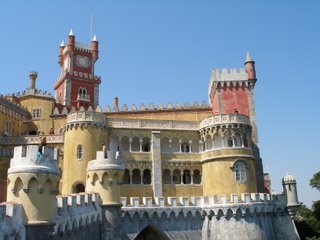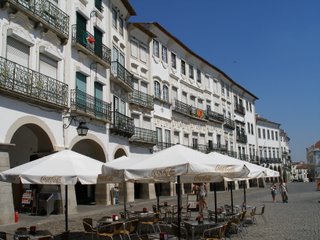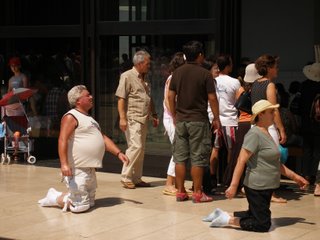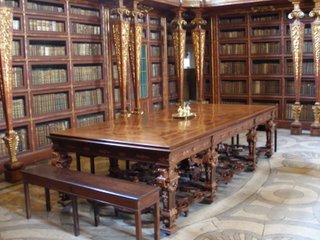Lisbon. Our very first stop was Portugal's capital, where I learned the Spanish term for "steep road," or "cuesta," because I would hear José María utter it in a characteristic frustrated tone all the time. Much to our disappointment, a big part of the historic quarter was spread out in an elevated section of the city. So walking the streets of Lisbon was like training to be a mountaineer, aggravated by the 40-degree summer heat which made us buy bottled water a lot of times. Portugal's capital for the most part is dirty and disorderly. The old houses seem to fall into ruin, paint chipping off their walls and droplets of stale water skydiving onto your head from the rusting roofs of five-storey buildings. Right below is a typical residential building in the historic quarter.
 Belém. Strictly speaking, Belém is still part of Lisbon except that it is six kilometers from the city center and looks like a different world altogether. It sits by the river and offers a splendid view of the waters lined by a bridge so tall it is almost a skyscraper! Belém's main attraction is a 16th-century monastery declared by UNESCO as a world heritage site, which transports you back into an era long gone as soon as you step into it. Here's a picture of the lovely cloister.
Belém. Strictly speaking, Belém is still part of Lisbon except that it is six kilometers from the city center and looks like a different world altogether. It sits by the river and offers a splendid view of the waters lined by a bridge so tall it is almost a skyscraper! Belém's main attraction is a 16th-century monastery declared by UNESCO as a world heritage site, which transports you back into an era long gone as soon as you step into it. Here's a picture of the lovely cloister. Sintra. Before we decided to go to Portugal, I'd told Jose Maria that we must strive to do some physical activity, aside from the usual church-hopping which he liked no end. Sintra was the closest we got to being "physical." There was a fairy-tale-like castle on top of a hill from where, on our way back, we had to hike because a fallen tree somewhere had blocked the roads that the buses couldn't pass. We saw a lot of trees, some ducks, horses, and a rather boring lake. Not bad, haha! Here's a picture of the castle.
Sintra. Before we decided to go to Portugal, I'd told Jose Maria that we must strive to do some physical activity, aside from the usual church-hopping which he liked no end. Sintra was the closest we got to being "physical." There was a fairy-tale-like castle on top of a hill from where, on our way back, we had to hike because a fallen tree somewhere had blocked the roads that the buses couldn't pass. We saw a lot of trees, some ducks, horses, and a rather boring lake. Not bad, haha! Here's a picture of the castle. Évora. This place is white. The houses, the public buildings, even the restaurants are white. It reminds me of the Spanish region of Andalucia where most of the old houses are white. The only thing that's not white in Évora is the cathedral and some unpainted buildings that have retained their natural stone color. The historic centre, also a UNESCO-protected site, constitutes a small town in itself and is set apart from the rest of the city by walls. Here's a picture of a white building.
Évora. This place is white. The houses, the public buildings, even the restaurants are white. It reminds me of the Spanish region of Andalucia where most of the old houses are white. The only thing that's not white in Évora is the cathedral and some unpainted buildings that have retained their natural stone color. The historic centre, also a UNESCO-protected site, constitutes a small town in itself and is set apart from the rest of the city by walls. Here's a picture of a white building. Fátima. On our fifth day in Portugal, we found ourselves with nowhere to go. The previous night, we had been to check out the gay scene in Lisbon (which didn't amount to anything really), so we woke up with bloodshot eyes and a mild headache. At the bus station we wanted to pick a destination at random and it somehow occurred to us to visit Fátima. The city itself is not a marvel but the Virgin's apparition to Lúcia, Francisco and Jacinta piques the curiosity of many. The place was filled with pilgrims, camp sites and rosaries for sale. Here's a picture of some devotees who walk on their knees from the southern part of the square to the miracle site.
Fátima. On our fifth day in Portugal, we found ourselves with nowhere to go. The previous night, we had been to check out the gay scene in Lisbon (which didn't amount to anything really), so we woke up with bloodshot eyes and a mild headache. At the bus station we wanted to pick a destination at random and it somehow occurred to us to visit Fátima. The city itself is not a marvel but the Virgin's apparition to Lúcia, Francisco and Jacinta piques the curiosity of many. The place was filled with pilgrims, camp sites and rosaries for sale. Here's a picture of some devotees who walk on their knees from the southern part of the square to the miracle site. Coimbra. We arrived in Coimbra on Sunday morning so the place seemed peaceful and dreamy. Only a few cars were on the streets and most commercial establishments were closed. If there's one thing I liked about this city it certainly was the university, which the Portuguese consider as the "Oxford of Portugal" because it is old and has great architectural value, unlike most modern European universities. A small corner of the 18th-century library is shown in the following picture.
Coimbra. We arrived in Coimbra on Sunday morning so the place seemed peaceful and dreamy. Only a few cars were on the streets and most commercial establishments were closed. If there's one thing I liked about this city it certainly was the university, which the Portuguese consider as the "Oxford of Portugal" because it is old and has great architectural value, unlike most modern European universities. A small corner of the 18th-century library is shown in the following picture. Oporto. Old houses, huge crowds. Pretty much resembles the 19th-century Manila I've seen in black and white photos. I consider Oporto one of the most memorable for four reasons. First, because on the day that I had to wash my clothes all the laundry shops seemed closed and I felt seriously threatened to put on used underwear. Second, because we group-toured a wine stockhouse and it was my first time to go to a wine-tasting (pic below). Third, because Oporto wine is sweet and has 20% alcohol content! Fourth, because it rained a lot even if it was summer.
Oporto. Old houses, huge crowds. Pretty much resembles the 19th-century Manila I've seen in black and white photos. I consider Oporto one of the most memorable for four reasons. First, because on the day that I had to wash my clothes all the laundry shops seemed closed and I felt seriously threatened to put on used underwear. Second, because we group-toured a wine stockhouse and it was my first time to go to a wine-tasting (pic below). Third, because Oporto wine is sweet and has 20% alcohol content! Fourth, because it rained a lot even if it was summer. Braga. This is one place I don't remember a lot about. I think it's got the usual churches and other historical stuff. We were supposed to go to Bom Jesus do Monte, a church perched on a hilltop, but we missed the city bus, which made us miss the funicular, which gave us no time to hike all the way to the church because we had already bought the tickets for the ride back to Oporto. To José María's disappointment, we just meandered around the foot of the hill. Here's a picture of the main plaza.
Braga. This is one place I don't remember a lot about. I think it's got the usual churches and other historical stuff. We were supposed to go to Bom Jesus do Monte, a church perched on a hilltop, but we missed the city bus, which made us miss the funicular, which gave us no time to hike all the way to the church because we had already bought the tickets for the ride back to Oporto. To José María's disappointment, we just meandered around the foot of the hill. Here's a picture of the main plaza.
No hay comentarios:
Publicar un comentario